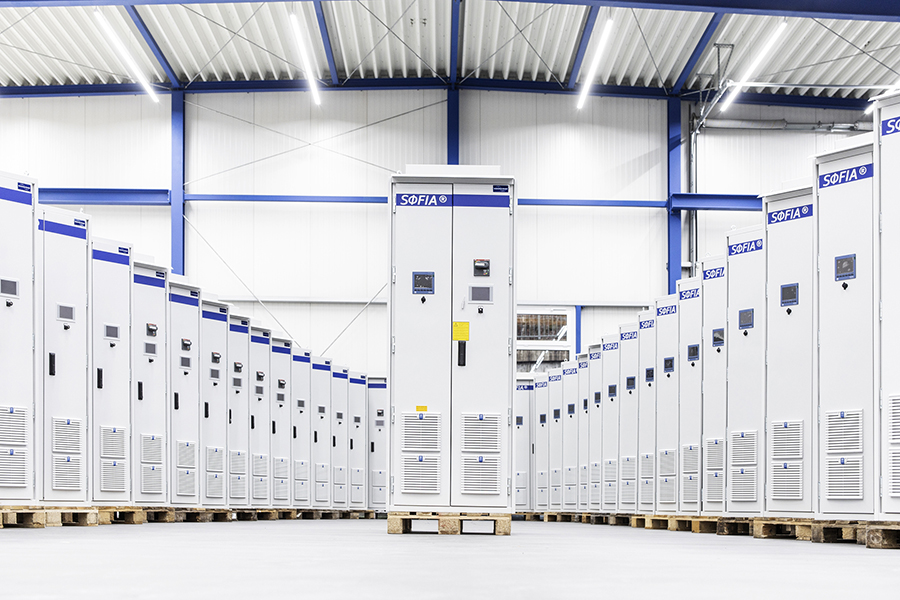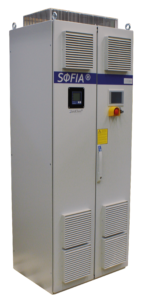Here you will find the necessary insights into our SΦFIA® product range and other related power quality information:
YOUR VOLTAGE –
OUR PASSION

SΦFIA®
Introduction: Intelligent components, decentralized controls, etc. are now distributed throughout the entire industrial plant field. With this trend, power quality in the network is also gaining importance as the devices are sensitive to disturbances. These include, above all, harmonics or “harmonics”. They can destroy equipment, influence electronic controls or even excite critical resonances. Utilities are guided by the DIN EN 50160 standard, and in the event of massive deviations, they would be liable in the event of damage.
Conversely, this also means that the devices operated by an electricity customer must tolerate interference within the limits. The limits defined in the product control standard IEC 61000-2-4 are decisive for this. In borderline cases, it is likely to be difficult and costly to determine whether the interference was too great or a device was too sensitive. The damage is there, causing costs and endangering plant availability. And it gets worse: It is possible that the faults are “home-made”. Switched-mode power supplies and frequency converters in particular can have a considerable effect on the voltage quality. The plant operator must therefore take remedial action himself. This can be done particularly well and easily with the SΦFIA® harmonic filter.
Mode of operation: Classic harmonic filters are based on the series connection of a capacitor and an inductor. The circuit has a fixed tuning frequency at which the filter has its lowest impedance and thus the greatest suction. Failure to optimally design such a system will result in high losses and thus unnecessary costs for energy and possibly cooling measures.
SΦFIA® on the other hand is an actively controlled harmonic filter with automatic impedance control. For this purpose, the device has several capacitors that are automatically switched on and off depending on the harmonic level. This allows the tuning frequency to be varied and the filter current to be kept almost constant over a wide range.
However, not only changes in the harmonic level can be taken into account by switching the stages, but also changes in the mains frequency as well as age- and temperature-dependent changes in the installed capacitors. This increases the service life of the device and saves costly measures to adapt to the new conditions in the network.
SΦFIA® already saves costs during the planning stage, as individual design is not necessary. The device is immediately ready for use and reacts independently to changes in the system. SΦFIA® is voltage-controlled, therefore no on-site current transformers are required and the function is also guaranteed in meshed networks with harmonic generators distributed over the entire network.
Conversely, this also means that the devices operated by an electricity customer must tolerate interference within the limits. The limits defined in the product control standard IEC 61000-2-4 are decisive for this. In borderline cases, it is likely to be difficult and costly to determine whether the interference was too great or a device was too sensitive. The damage is there, causing costs and endangering plant availability. And it gets worse: It is possible that the faults are “home-made”. Switched-mode power supplies and frequency converters in particular can have a considerable effect on the voltage quality. The plant operator must therefore take remedial action himself. This can be done particularly well and easily with the SΦFIA® harmonic filter.
Mode of operation: Classic harmonic filters are based on the series connection of a capacitor and an inductor. The circuit has a fixed tuning frequency at which the filter has its lowest impedance and thus the greatest suction. Failure to optimally design such a system will result in high losses and thus unnecessary costs for energy and possibly cooling measures.
SΦFIA® on the other hand is an actively controlled harmonic filter with automatic impedance control. For this purpose, the device has several capacitors that are automatically switched on and off depending on the harmonic level. This allows the tuning frequency to be varied and the filter current to be kept almost constant over a wide range.
However, not only changes in the harmonic level can be taken into account by switching the stages, but also changes in the mains frequency as well as age- and temperature-dependent changes in the installed capacitors. This increases the service life of the device and saves costly measures to adapt to the new conditions in the network.
SΦFIA® already saves costs during the planning stage, as individual design is not necessary. The device is immediately ready for use and reacts independently to changes in the system. SΦFIA® is voltage-controlled, therefore no on-site current transformers are required and the function is also guaranteed in meshed networks with harmonic generators distributed over the entire network.
Advantages
- Low power dissipation
- No shutdown in case of overload
- Both mains and load-side filtering
- Broadband filtering of multiple frequencies
- Filtering of several frequencies with one filter module
- Voltage-controlled regulation without current transformers on the customer side

